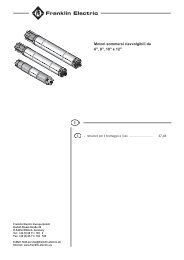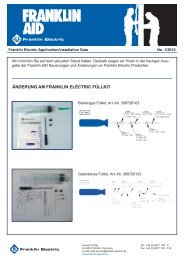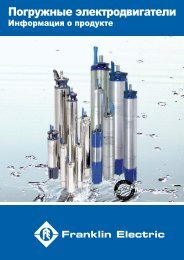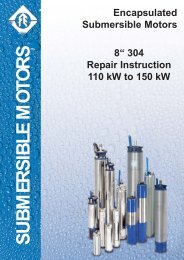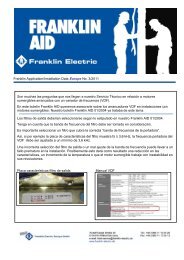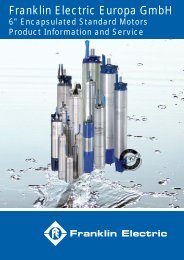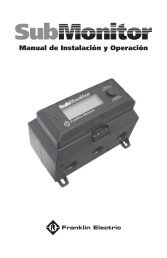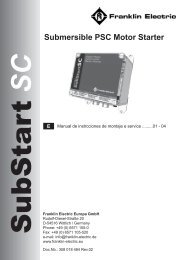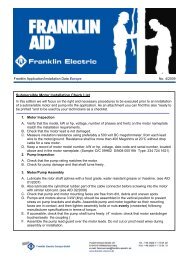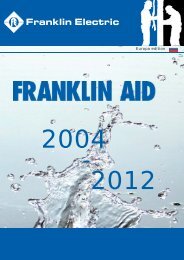AID - Franklin Electric Europa
AID - Franklin Electric Europa
AID - Franklin Electric Europa
You also want an ePaper? Increase the reach of your titles
YUMPU automatically turns print PDFs into web optimized ePapers that Google loves.
<strong>Europa</strong> edition2003-2012
<strong>Franklin</strong> <strong>AID</strong>Summary2003200420052006200720082009201020112012<strong>AID</strong> 1 The <strong>Europa</strong> Field Service Team / Seminar Dates<strong>AID</strong> 2 <strong>Electric</strong>al Troubleshooting Submersible Motors, Part 1<strong>AID</strong> 3 <strong>Electric</strong>al Troubleshooting Submersible Motors, Part 2<strong>AID</strong> 4 Mechanical Troubleshooting Submersible Motors<strong>AID</strong> 1<strong>AID</strong> 2<strong>AID</strong> 3<strong>AID</strong> 4Variable Speed Submersible Pump OperationMinimum Requirments for a Successful Borehole Pump InstallationThe Construction of Submersible Motors - Part 1: <strong>Electric</strong>al DesignThe Construction of Submersible Motors - Part 2: Mechanical Design<strong>AID</strong> 1 The Construction of Submersible Motors - Part 3: Motor design overview<strong>AID</strong> 2 Motorleads - Part 1<strong>AID</strong> 3 Ampacity and the voltage drop<strong>AID</strong> 4 Lightning/Voltage surges and their effects<strong>AID</strong> 1<strong>AID</strong> 2<strong>AID</strong> 3<strong>AID</strong> 4<strong>AID</strong> 1<strong>AID</strong> 2<strong>AID</strong> 3<strong>AID</strong> 4<strong>AID</strong> 1<strong>AID</strong> 2<strong>AID</strong> 3<strong>AID</strong> 4<strong>AID</strong> 1<strong>AID</strong> 2<strong>AID</strong> 3<strong>AID</strong> 4<strong>Franklin</strong>Tech - Training CenterThe <strong>Electric</strong>al Condition of a Motor from Measuring the Insulation ResistanceField ToolsFE-Submersible Motors in Low Temperature RangeFight against SPLINE WEARTemperature control of submersible motorsTemperature control of submersible motors - SubMonitorTemperature control of submersible motors - PT100Derating4" Lead InstallationChange of colours of connection cables according to the harmonizationdocument 308Practical training center / PT100 Cable Colours / FE Date Code SystemCorrosion protection for 4inch 304SS motorsMotor cooling / Repair instruction PE2/Pa motor leadSubStartSC Control Box / Motor Test ReportSubmersible Motor Installation Check List<strong>AID</strong> 1 <strong>Franklin</strong> <strong>Electric</strong> Single phase motors - part 1<strong>AID</strong> 2 <strong>Franklin</strong> <strong>Electric</strong> Single phase motors - part 2<strong>AID</strong> 3 <strong>Franklin</strong> <strong>Electric</strong> Single phase motors - part 3<strong>AID</strong> 4 <strong>Franklin</strong> <strong>Electric</strong> Single phase motors - part 4<strong>AID</strong> 1<strong>AID</strong> 2<strong>AID</strong> 3<strong>AID</strong> 1<strong>AID</strong> 2<strong>Franklin</strong> <strong>Electric</strong> Control Box and motor OverviewSubmersible motors in combination with a VFDChanges to the FE Motor Filling-Kit; New 6" Rewindable and Encapsulated 304SS MotorsPosition Change of the Date Code and Sequence Number on 4" MotorsThe understanding about electrical power,in terms of calcu-lating the electrical cost of operatinga submersible pump.
In dieser Ausgabe möchten wir Ihnen „Das Design und die Konstruktion von Unterwassermotoren: Teil 1“vorstellen.Wenn Sie eine Unterwasserpumpe mit Motor installieren, erwarten Sie, dass der Motor jahrelang zuverlässigarbeitet und dabei seine Nennleistung für den gewünschten Einsatz abgibt. Elektromotoren sind normalerweisenicht für den Einsatz unter Wasser gebaut; sie müssen speziell für diese Anforderungen konstruiert werden.<strong>Franklin</strong> <strong>Electric</strong> ist Pioneer auf dem Gebiet von Design- und Konstruktionslösungen für leistungsfähige undstandfeste Unterwassermotoren für den Brunneneinsatz. Die hier aufgezeigten Designmerkmale sind das Ergebnisvon Erfahrungen, die bei der Herstellung und dem Einsatz von vielen Millionen Unterwassermotoren gewonnenwurden. Die zentrale Frage bei der Herstellung eines Unterwassermotors ist: Wie schütze ich diespannungsführenden Kupferwicklungen im Stator vor Wasser? (Da Wasser ein natürlicher Leiter für Elektrizität ist,würde dies zu einem Kurzschluss führen). Ein weiterer Gesichtspunkt wird in der nächsten <strong>AID</strong> thematisiert: Dermechanische Aufbau. In tiefen Brunneninstallationen betragen die Bergekosten ein Vielfaches des Preises desErsatz-Aggregates. Aus diesem Grund müssen Unterwassermotoren so konstruiert sein, dass ein langer, wartungsfreierBetrieb in ihrem natürlichen Element, dem Wasser, möglich ist.Zur Zeit gibt es 3 verschiedene Motorkonstruktionen am Markt: SpaltrohrmotorDie Lamination ist mit den Wicklungen in einen Edelstahlzylinder eingepresst und umlaufend wasserdicht verschweißt.Mit einem patentierten System wird ein dünnes Edelstahl-Spaltrohr innen im Stator eingebracht, welcheses den eingeschlossenen Wicklungen erlaubt, elektrisch so zu agieren, als wären diese nicht innerhalb eineswasserdichten Gehäuses. Der vom Stator und den Motorendteilen eingeschlossene Innenraum ist komplett mitWasser und Propylenglycol gefüllt, um einem Frostschaden vorzubeugen. In diesem niederviskosen Wassermediumdreht der Rotor mit Antriebsverzahnung mit sehr hoher Effizienz. Das Wassermedium erlaubt allen beweglichenTeilen im Motor uneingeschränkte Kühlung und Schmierung. Beim wassergefüllten Design würden geringfügigeMengen von Brunnenwasser, die in den Motor eintreten könnten, keinerlei Schaden anrichten. Wiederwickelbarer Motor – NassläuferBei diesem Design sind die Wicklungen durch eine Drahtumhüllung mit einer Schicht aus entweder PVC oderPE2PA abgedichtet. Diese Ausführung hat die gleichen Stärken wie die der hermetisch abgedichteten Spaltrohrmotoren,aber einige Punkte sind zu beachten: Auswahl des Isolationsmaterials bei der Fabrikation, sowie diegrößere Baulänge aufgrund geringerer Kupferfüllung der Laminationsnuten. Schmierung und Innenkühlung erfolgenebenfalls durch eine Wasserfüllung. Ölgefüllte MotorenBei ölgefüllten Motoren werden standardisierte, lackdrahtisolierte Kupferwicklungen verwendet. Die Füllflüssigkeit dieMotoren ist nicht wasserbasierend sondern Öl, welches die Kühlung des Motors und die Isolation der elek-trischen Teübernimmt. Zusätzlich dient es auch der Lagerschmierung. Die Lager sind in den meisten Fällen als Kugellagerausgeführt. Wegen der Isolierung und der starken Verschlechterung der Schmiereigenschaften von Ölbei Eindringen von Wasser in den Motor, muss ein besonderes Augenmerk auf die Auswahl geeigneter, hochqualitativerDichtungskomponenten gelegt werden, in Verbindung mit sehr hohem Qualitätsstandard während derMotorfertigung.In der nächsten Ausgabe der <strong>AID</strong> werden wir mit Materialien und Komponenten von Unterwassermotorenfortfahren.<strong>Franklin</strong> <strong>Electric</strong> Submersible Seminars 2005Spring 2005:North of FrancePortugalSpainPlease visit our website at www.franklin-electric.de for more information and details on future trainings andseminars or contact us directly at field-service@franklin-electric.de.
<strong>Franklin</strong> Application/Installation Data EuropeNo. 4 / 2004This edition will highlight: “The Construction of Submersible Motors Part 2 : Mechanical Design”Technically speaking, the submersible motor is an asynchronous motor, featuring a stator, a rotor and bearings justlike any other above ground motor. Its mechanical design however needs to account for the very specific environmentand load that it has to carry: it lives its life under water, in narrow boreholes, with sometimes aggressivechemical behaviour or high dissolved solid contents. The motor drives a multistage submersible pump that bydesign exercises a certain downward oriented thrust load on the motor shaft. Thus, a submersible motor is of slim,long shape, with two or more radial bearings to center the rotor and an additional thrust bearing to carry the pumpload. Its constituting materials in contact with the environment are of corrosion resistant materials. A shaft sealkeeps the filling liquid inside and a pressure equalizing diaphragm allows for its heat expansion.In more detail: Bearing SystemEspecially the rotor bearing design in submersible motors is of particular interest: Normally, ball bearings would beused for radial purpose and angular contact bearings for combined radial/thrust loads. As in submersible motors itis desirable to have water-based cooling and lubrication fillings, ball bearings are not the first option, although theyare used in the oil-filled design. Also, as already discussed, because of high pulling costs, lifetime without the needof maintenance is of major concern. Considering the above, slide bearings have been found to offer theoreticallyunlimited lifetime with best behaviour in water-based lubrication. For both Encapsulated and Rewindable submersiblemotors, <strong>Franklin</strong> <strong>Electric</strong> uses hydrodynamic slide bearings. Our radial bearings consist of stainless steel shaftsleeves and carbon journals as bearing partners. When the rotor comes to speed, a water cushion is built upbetween the stationary carbon journal and the rotating stainless steel sleeve, so there is virtually no mechanicalcontact between the two components and consequently no wear. The thrust bearing also makes use of the samematerials: it consists of a rotating carbon disc and a number of stationary, tilting stainless steel pads. In normaloperation, a very thin water film is drawn between the pads and the carbon disc, which makes the thrust disc to“float” over the pads. This is comparable with the “aquaplaning” phenomenon known to most automobile drivers,and again results in theoretically no wear and long, maintenance-free bearing life. Obviously, it has to be made surethat the original filling liquid does not get contaminated with solids, and here is where the shaft seal steps in. Sealing systemThe inner part of the motor is filled with liquid for the purpose of lubrication, cooling and pressure equalization. Thisfilling operation is performed at the factory with a water-based, clean filling liquid. Ideally, this liquid will not beexchanged for the entire lifetime of the submersible motor. To guarantee this, all joints of the motor are equippedwith sealing components such as O-rings, flat gaskets and a lip- or mechanical seal for the shaft. To protect theseal from excessive wear by solids in suspension which are normally observed in well water, a sand slinger is fittedon the shaft to cover the seal area. Submersible motors also need a volume compensating diaphragm that allowsfor the heat expansion of the filling liquid captured inside the motor. As a positive side effect, the diaphragm alsoequalizes the pressure inside and outside of the motor for the various submergence depths.The next edition will continue with leads and lightning arrestors.<strong>Franklin</strong> <strong>Electric</strong> <strong>Europa</strong> GmbHRudolf Diesel Straße 20D-54516 Wittlich/GermanyTel.: +49 (0)65 71 10 54 20Fax: +49 (0)65 71 10 55 13e-mail: field-service@franklin-electric.dewww.franklin-electric.de
Diese Ausgabe beschäftigt sich mit der „Konstruktion von Unterwassermotoren, Teil 2: Mechanik“Aus technischer Sicht ist ein Unterwassermotor ein Asynchronmotor, bestehend aus Stator, Rotor und Lagern,ähnlich den normalen, trocken aufgestellten Elektromotoren. Der mechanische Aufbau ist jedoch an die speziellenEinsatzbedingungen im Bohrloch angepasst: engster Raum, permanente Wasserüberdeckung, Einsatz in aggressivenoder mit Feststoffen versetzten Medien. Der Motor treibt eine mehrstufige Pumpe an, welche konstruktionsbedingteine zum Motor hin wirkende Drucklast auf die Motorwelle abgibt. Daher ist ein Unterwassermotor schmalund lang gebaut, mit 2 oder mehr Radiallagern zur Zentrierung des Rotors und zusätzlichem Axiallager, um dieDrucklast der Pumpe aufnehmen zu können. Die mit dem Umgebungsmedium in Kontakt stehenden Komponentendes Motors sind aus korrosionsbeständigen Materialien ausgeführt. Eine Wellendichtung sorgt dafür, dass dieMotor-Füllflüssigkeit nicht austritt und eine Membrane ermöglicht der Füllflüssigkeit, sich bei Volumenvergrößerungdurch die beim Betrieb entstehende Wärme auszudehnen. LagersystemSpeziell die Rotorlagerung ist bei Unterwassermotoren von besonderem Interesse. Bei herkömmlichen Elektromotorenwerden die auf den Rotor wirkenden Druck- und Seitenlasten normalerweise durch Kugellageraufgenommen. Für Unterwassermotoren ist es jedoch erstrebenswert, eine wasserbasierende Kühl- undFüllflüssigkeit im Motor-inneren zu verwenden, welche dann auch die Lagerstellen umgibt. Da diese Art vonFlüssigkeit zur Schmierung normaler Kugellager ungeeignet ist, kommen diese nur in ölgefülltenUnterwassermotoren zum Einsatz. Außerdem ist aufgrund hoher Bergungskosten die Wartungsfreiheit dieserspeziellen Motorenart von primärem Interesse. Unter Berücksichtigung der oben aufgeführten Gründe haben sichin wassergefüllten Bohrlochmotoren Gleitlager durchge-setzt, welche eine zumindest theoretisch unbegrenzteStandzeit bei gleichzeitig minimalem Wartungsaufwand versprechen. Demzufolge verwendet <strong>Franklin</strong> <strong>Electric</strong>sowohl bei Spaltrohr- als auch bei wiederwickelbaren Motoren hydrodynamische Gleitlager. Die Radiallagerbestehen aus einer Edelstahl-Wellenhülse, die in einerKohlebuchse läuft. Ab einer bestimmten Rotordrehzahl baut sich ein Schmierfilm zwischen stationärerKohlebuchse und rotierender Edelstahl-Wellenhülse auf, so dass praktisch kein mechanischer Kontakt zwischenden beiden Teilen besteht und demzufolge auch kein Verschleiß auftritt. Das Drucklager verwendet dieselbenMaterialien, besteht jedoch aus einer rotierenden Kohlescheibe und mehreren feststehenden, kippbaren Edelstahl-Segmenten. Ähnlich dem den meisten Autofahrern bekannten „Aquaplaning“-Phänomen baut sich im Betrieb desMotors ein dünner Wasserfilm zwischen der Kohlescheibe und den Segmenten auf, welcher der Kohlescheibeerlaubt, berührungslos über die Segmente zu gleiten. Dies resultiert in einer theoretisch unbegrenzten Standzeitund Wartungsfreiheit des Lagers, vorausgesetzt, die Original-Füllflüssigkeit wurde nicht durch Festkörperverschmutzt. DichtsystemDas Motorinnere wird im Herstellerwerk zum Zweck der Schmierung, Kühlung und des Druckausgleichs mit einerwasserbasier-ten, sauberen Flüssigkeit gefüllt. Idealerweise wird diese Flüssigkeit über die gesamte Lebenszeitdes Motors nicht ausgetauscht oder kontaminiert. Dies wird durch ein ausgeklügeltes Dichtsystem bestehend ausWellendichtung, Membrane sowie diversenO-Ringen bzw. Flachdichtungen erzielt. Die meisten Brunnengewässer beinhalten einen gewissen Anteil vonFeststoffen in Suspension (Sand), welche zu erhöhtem Verschleiß an der Wellendichtung führen kann. Um dies zuverhindern, besitzen Unter-wassermotoren einen Sandschleuderring auf dem Wellenende. Da sich Elektromotorenwährend des Betriebes erwärmen, muss für die Volumenausdehnung der eingefüllten Flüssigkeit gesorgt werden.Diese Aufgabe übernimmt eine elastische Membrane, welche zugleich den Druckausgleich zwischenMotorinnerem und Umgebung sicherstellt, unabhängig von der Einsatztiefe.Die nächste Ausgabe wird Kabel und Überspannungsableiter behandeln.<strong>Franklin</strong> <strong>Electric</strong> Submersible Seminars 2005Spring 2005:North of FrancePortugalSpainPlease visit our website at www.franklin-electric.de for more information and details on future trainings andseminars or contact us directly at field-service@franklin-electric.de.
<strong>Franklin</strong> Application/ Installation Data Europe<strong>AID</strong> 1/2005The previous editions of the <strong>Franklin</strong> <strong>AID</strong> dealt with different constructions and designs ofmotors. To finalize this subject you will find below drawings of the different designs in directcomparison.Encapsulated Oil filled RewindableHydrodynamic radialbearingHydrodynamic radialbearingFE filling solutionVarnished magnet wireBall bearingOil filledVarnished magnet wirePVC/PE2-PA coatedFE filling solutionEncapsulated statorHydrodynamic thrustbearingHydrodynamic radialbearingBall bearingHydrodynamic radialbearingHydrodynamic thrustbearingWe are glad to introduce our new Field Service EngineerMr. Alberto Fornasier. He took over responsibility for theareas Italy, Greece and the corresponding islands.You can reach him under the following numbers:Phone: +39 0422 761 713Fax: +39 0422 761 711email: afornasier@fele.com
<strong>Franklin</strong> Application/ Installation Data Europe<strong>AID</strong> 2/2005In this and the next issue of our FE <strong>AID</strong>, we will discuss the leads and drop cablesused with submersible motors.The electrical power from the grid/power supply needs to be taken all the way down to thesubmersible motor, which is done by means of electrical power cables. Practically, in boreholepump installations one divides between “motor short leads” and “drop cables”.Definitions: The leads directly connected to the submersible motor, generally a few meterslong, are to be considered “motor short leads”. Because these leads need to be takenalongside the pump and underneath a cable guard, the main design feature for these leadsis “flat and narrow”. So, for practical reasons, motor manufacturers choose the smallestpossible lead suitable to carry the motor’s nameplate current under water. The cooling bythe well water of the smaller gauge lead size is sufficient.Also, even though this lead’s cross-section is low, because of its shortness there will be nonoticeable voltage drop on this portion. Because of it’s shortness there will be no noticeablevoltage drop on this portion, even though this lead’s cross-section is low.These motor short leads are then spliced to a generally thicker (larger cross-section) cablecalled “drop cable”. Because the riser pipe is generally narrower than the pump, there areno space limitations to be observed for drop cables. Also, as opposed to the motor shortlead, at least a portion of the drop cable will be taken out of the water and into the controlpanel of the pump. Thus, this cable needs to be able to carry the full line current of the motorin air at specified temperatures.While the motor manufacturer chooses the appropriate gauge for the motor short lead, sizingthe drop cable to be both cost-effective and technically correct can be a challenge.Two aspects need to be considered here: ampacity and voltage drop.The next <strong>Franklin</strong> <strong>AID</strong> will go on with ampacity, voltage drop and crimping.
<strong>Franklin</strong> Application/ Installation Data Europe<strong>AID</strong> 3/2005The last FE <strong>AID</strong> started with the motor leads. In this <strong>AID</strong> we will focus the ampacity and the voltagedrop.The ampacity represents the maximum current a cable is designed to permanently carry under specifiedmounting and environmental (liquid/gas, temperature, conduit) conditions. It is listed in the catalogues of thecable manufacturers. For long cable runs, the cable impedance represents a load that causes a voltage/powerloss. In other words, the full voltage applied at the grid does not reach the motor service entrance. <strong>Franklin</strong><strong>Electric</strong> requests that the voltage drop across the drop cable is not greater than 5% of the rated voltage. Thefirst step is to determine the minimum (because most economic) lead crossection that can carry the full linecurrent of the motor in air at specified temperature, using the cable manufacturers catalogues. Then, the voltagedrop across the drop cable run needs to be calculated. If cables are long (50-300m), the previously determinedminimum crossection will probably cause a voltage drop over 5% of the nominal voltage. In this case,the next larger cable needs to be verified, until the voltage drop results within limits.The way of connecting the motor short leads to the drop cable is an important factor in achieving the desiredlifetime of your borehole pump installation. Today, four different methods are widely in use: taping, splicing byresin casting, heat shrinking, a combination of any of these. These connections need to make good electricalcontact, be mechanically reliable and properly sealed for required submergence. Another important aspect isthe suitability of these leads/cables for use in drinking water.As required by CE regulations, submersible motor leads are double insulated: they feature a core insulationand a sheath. The latter is in permanent contact with the pumped liquid; therefore most customers requirecertified leads that would not pollute the drinking water. <strong>Franklin</strong> <strong>Electric</strong> <strong>Europa</strong> GmbH motor leads meet allmajor drinking water standards and carry both the KTW and ACS drinking water approvals.Technical News: New Generation of our 8”+10” Rewindable MotorsInternal Mechanical Seal with additional SandslingerPressurized interior due to spring preloaded DiaphragmOptional Material 904L, ensures:Enhanced Lifetime in abrasive applications, proven in a 12 month field trialHorizontal Application without additional Equipment (except 8“-93 Kw and 10“-185 Kw)No changes to the physical dimensions and the electrical performance !For further details, please contact your <strong>Franklin</strong> <strong>Electric</strong> Area Sales Manager or Field Service Engineer.New seal parts New seal parts assembled New Spring Spring mounting tool
<strong>Franklin</strong> Application/ Installation Data Europe<strong>AID</strong> 4/2005Lightning/Voltage surges and their effects on submersible installationsShort duration voltage spikes are commonly generated by switching large inductive appliances under load or lightning thatstrikes overhead power lines. The two characteristic properties of such a spike are it’s very short duration (tiny part of a second)and very high magnitude (tenthousands of volts).These transient voltage spikes travel along the power lines looking for a path to earth (to ground themselves). By nature, thebest electrical ground is supplied by the underground water strata (aquifer), and this is exactly where the submersible motorsare situated. For this reason, the submersible borehole motor is more susceptible to be damaged by overvoltage thanother, above ground mounted appliances.How lightning/voltage surges do its damage.Arriving through the motor supply cables (drop cables), the surge will leave the power lines at the motor, jump across themotor winding insulation to motor frame, and dissipate itself to ground (water).The surge will no longer exist on the powerlines, except that a very small hole has been punctured through the motor winding insulation. If the motor is running at thetime, the current of the normal voltage supply will follow through this hole in the motor winding insulation. It is this powerfollow current which causes the damage. This current will be high (in the nature of a short circuit) and severe burning ofwindings and insulation will result that will ruin the motor windings. Remember: This whole procedure takes only a tiny partof a second.How to protect ?The industry offers a large variety of surge protectors (commonly referred to as lightning arrestors) to the consumers. Basically,these arrestors create a lower insulation resistance point in the way of the transient overvoltage. When the voltagesurge arrives at these devices, it will encounter them as a convenient, low resistance way to earth and will tend to grounditself through this device, thus protecting the downstream mounted electrical appliances. By construction, these lightningarrestors are capable of withstanding the very high transient discharge current as well as break the power follow current.The correct grounding of the surge arrester is of paramount importance for it’s capability to provide protection. For efficientprotection of submersible motors, the arrestor must be low resistance grounded to the same water strata the motor is installed.4” MotorsThe best way to do that would be to put a lightning/surge arrestor right into the motor itself, one arrestor for each wire comingin. The arrestors are in contact with the casing of the motor, which is in contact with the underground water. When thepower surge comes down the lead wires, the arrestors divert it to the casing, and then on into the water. And the arrestorskeep on diverting all parts of the surge into the water so there’s no double-power reflected voltage to damage a motor.<strong>Franklin</strong> <strong>Electric</strong> offers optional built-in lightning arrestors for its 4” SS motors. (Exclusion: 2-wire BIAC motors are as a standardfactory equipped with lightning arrestors)6” and larger MotorsFor the lightning protection of 6” motors and larger <strong>Franklin</strong> <strong>Electric</strong> recommends the use of commercially available 3-phasesurge arrestors. To provide best protection for the submersible motor, above ground arrestors must be installed as close tothe well head as possible. As described before, the suitability of the ground connection is all important: if the grounding ofthe arrestor is better than the ground afforded by the submersible motor, most of the high voltage surge will go through thelightning arrestor to ground and protection will be provided to the motor.Single phase lightning arrestor(in the motor installed)Three phase lightning arrestor(external)ConnectionSeminars:To check out our latest seminar schedule, please visit our website www.franklin-electric.de or contact us at:field-service@franklin-electric.de
<strong>Franklin</strong> Application/ Installation Data Europe<strong>AID</strong> 1/2006NEWS NEWS NEWS Seminar-Classroom„Hand‘s on“ -TrainingWe are excited to introduce the new <strong>Franklin</strong> Tech training center wich has beencompleted in Wittlich, Germany, as an extension of the various seminars offered inthe past. Individual emphasis will be placed on languages, product groups andcustomer specific requirements. Please contact us for our seminar schedule byphone +049-6571-105421 or email: field-service@franklin-electric.de.We gladly welcome a new addition to our Field Service Team:Andrej DielAfter completion of his electrotechnical studies in Russia Andrejgained experience working for an international company in Germany.Stationed in Berlin, he will offer his support and service to ourcustomers in Eastern Europe.He can be reached at:+49-170-3330344 or email: adiel@fele.com
<strong>Franklin</strong> Application/ Installation Data Europe<strong>AID</strong> 2/2006In this edition of the <strong>Franklin</strong> <strong>AID</strong> we want to answer a subject often inquired about:”What conclusion can be drawn about the electrical condition of a motor from the measuringof the insulation resistance?”In below table you will find the corresponding values. Please note that the insulationresistance may vary depending on the environmental temperature.Conditions of motor and lead Ohm MegohmNew motor (without lead)Motor to reinstall in the well (without lead)200.000.00020.000.000200 (and more)20 (and more)Motor in the well with leadNew motor 2.000.0002 (and more)Motor to reinstall in the well 500.000 - 2.000.000 0,5 - 2Defective motor insulation less 500.000 less 0,5All these measurements must be done at 500 V DC !Your assistance is required!If you let us know your e-mail address, you will receive the <strong>Franklin</strong> <strong>AID</strong> much sooner as anelectronic file.
<strong>Franklin</strong> Application/ Installation Data (<strong>AID</strong>) Europe 3/2006In this <strong>Franklin</strong> <strong>AID</strong> we would like to demonstrate the tools for the external service checks inthe field. The tools can be ordered via franklin dealers.Gauge156125101Gauge308239103Filling kit3087261034“/ 6“8“/ 10“Shaft height:4“ ENC. motor: 38,05 mm - 38,30 mm6“ ENC. motor: 72,88 mm - 73,02 mm8“ ENC. motor: 101,73 mm - 101,98 mm6“ REW. motor: 72,77 mm - 73,03 mm8“/10“ REW. motor: 101,4 mm - 101,6 mmDiaphragm position:4“ ENC. motor: 10 mm6“ ENC. motor: 59 mm /316: 19 mm8“ ENC. motor: 37 mm6“/8“ REW. motor: 44 mm10“ REW. motor: 64 mm Unfortunately there was an error in the last <strong>Franklin</strong> <strong>AID</strong>: In chapter 2 „Motor in the wellwith lead“ please ignore the addition in brackets („without lead“). Visit us at the EIMA/Bologna/Italy at 15. - 19. November 2006. To check out our latest seminar schedule, please visit our websitewww.franklin-electric.de or contact us at: field-service@franklin-electric.com
<strong>Franklin</strong> Application/ Installation Data (<strong>AID</strong>) Europe 4/2006We need your help!For more than 3 years we have been publishing our <strong>Franklin</strong> <strong>AID</strong>. Now we would like to ask for your help:According to statistics, every year 10% of a readership either change addresses or employment status. Thus, inorder to formally update our mailing list, we kindly ask you to submit the latest names and addresses (postal oremail) to where we shall direct our mailing. Please also inform us if you receive duplicate mailings or copies forsomeone no longer in your company.Now, as we are facing the cold season, let us examine:COLD WEATHER AND SUBMERSIBLES<strong>Franklin</strong> <strong>Electric</strong> submersible motors for use in standard water well applications are filled with a water-basedmixture, consisting of water and Propylene Glycol. This is to lubricate the motor’s internal bearing system and tokeep the motor from freezing during storage.Polypropylene Glycol – not to be confused with the toxic car antifreeze Ethlene Glycol – is safe for consumptionand being used in pharmaceuticals, ice cream, make-up and soft drinks.With the factory-installed filling solution, our submersible motors are kept from freeze damage in temperaturesas low as -40° Celsius. However, as the temperature drops down below -3° Celsius, the filling solution will beginto turn to slush and the shaft may no longer turn. But remember, no damage to the motor should occur with thefactory-installed, undiluted filling solution.The composition of filling solution varies for the different types of motors. <strong>Franklin</strong> <strong>Electric</strong> recommends usingFES filling solution exclusively for refilling or exchanging in order to achieve maximum storage and operationconditions. To determine the proper filling solution for the respective motor please check the AIM (Application-Installation-Manual) or consult your Field Service Engineer.Motor breathing and freezing conditionsDuring operation, the normal motor heating causes an expansion of the filling solution. Most of this is acceptedby the diaphragm, although some of the filling solution may leak out of the motor around the seal. When the motorhas cooled, <strong>Franklin</strong> <strong>Electric</strong> standard motors can pull well water through an installed filter into the motor bymeans of a check valve. How fast and often this exchange occurs depends on run times, frequency of starts andother factors surrounding the operation of the pumping system. This means that after years of operation the motorhas exchanged its filling liquid with well water, making it sensitive to freezing. Please refill used motors withthe FES filling solution or store them indoors.Another option for winter storage of motors working in fountains or cascading wells is to sink the motor to thebottom of the pond and thus assure it is below freezing level.Please note: The filter is replaced with a sealed pipe plug on 316 Stainless Steel motors to avoid entry ofaggressive water into the motor. To check out our latest seminar schedule, please visit our website www.franklin-electric.deor contact us at: field-service@franklin-electric.de
<strong>Franklin</strong> Application/ Installation Data (<strong>AID</strong>) Europe 1/2007Fight against SPLINE WEARIn this <strong>Franklin</strong> <strong>AID</strong> we would like to point out some facts about couplings and splines.RECOMMENDATIONS:1. Coupling:- Coupling material (powdered metal parts) needs to be compressed as high aspossible (of high density).- Assure coupling splines are dimensionally correct to provide uniform toothloading.- Assure quality of coupling material is matching material of the shafts (in orderto avoid galvanic currents).- Couplings featuring a hardened washer between pump and motor shaft ends arethe preferred option (avoids chips in the spline area).2. Lubrication: The spline compartment of rotor and coupling must be filled properlywith a water proof silicon grease, or if not available: Vaseline, to be found in anypharmacy.3. Loose fitting coupling (coupling shall be tied fixed on pump shaft, but free on rotor splines).4. Sealing: Make sure coupling is designed to touch the rotating sandslinger, in order to avoid entry of abrasiveparticles into the spline area.5. Misalignment: When mounting pump to motor, it should be checked, if motor and pump are properly in oneline.- Wet ends with plastic or very lean investment casting/sheet metal inlets are likely to cause misalignment.6. Centering: Motor to pump must center properly each other to avoid any side–load.7. Respect maximum recommended torques of the pump manufacturer when attaching the pump to the motor.8. Handle long units (higher head pumps already attached to motors) with care to avoid permanent deformation.Reduced spline lifetime due to:· Upthrusting conditions, i.e. pump operation at the very right hand side of the pump curve (large quantity, smalltotal head).· Water hammering, high dynamic conditions in the pipe system.· Frequent switching (on and off), such as with broken bladder in the pressure vessel.Recommendation: Max. 20 per hour.- Chattering relay contacts.· Overpumping, possibly due to wrong pump selection, creating sudden changes in torque (pump discharge largerthan well water supply).· Motor back spin, resulting in increased shock loading on motor start-up (faulty pressure system, leaking checkvalve).· Excessive or insufficient revolutions (as a result of backspinning due to a leaking or missing check valve).· Pump cavitation will shock load the splines and/or induce vibrations which may cause stripped spline oraccelerated spline/coupling wear (right selection of pump in accordance to suction conditions – NPSH).
<strong>Franklin</strong> Application/ Installation Data (<strong>AID</strong>) Europe 2/2007Temperature control of submersible motorsAttached we want to show our temperature control portfolio. This additional temperature control does not replacethe thermal motor protection (according to EN60947-4-1).Please address further questions to: field-service@franklin-electric.de.Encapsulated MotorRewindable MotorPT100ReceiverPT100 SensorretrofitablePT100 SensorretrofitablePT100ReceiverMust be providedon siteMust be providedon siteSubmonitorSubtrol SensorModification of diaphragm cover screw by 4” motorsStarting Date Code 07A62 (January 2007) the formerly used slotted screw was gradually replaced by a combinationdrive & truss head screw. Exception: the 2 wire Motor (244…)!TX 25
<strong>Franklin</strong> Application/Installation Data (<strong>AID</strong>) Europe 3/2007In our last edition we gave an overview of the various motor protection options. Let’s go into detailand inform you about the benefits of the FE SubMonitor.The SubMonitor can be used for the protection of encapsulated <strong>Franklin</strong> <strong>Electric</strong> motors (3 phasefrom 2,2 kW to 150 kW). Current, voltage and motor temperature are monitored using three integratedcurrent transformers. Motors from 37 kW to 150 kW are factory equipped with the Subtrol heatsensor. Motors below these ratings can be ordered optionally.Monitors:• Under- and Overload• Current unbalance• False Start (Chattering)• Under- and Overvoltage• Phase reversal• Overheated motor(when motor is Subtrol equipped)• No additional cableFEATURES:• Voltages from 190 V to 600 V• AMPS range from 3-359 AMPS• Password protection option• DIN rail mounting Option• Stores fault, setting changes, andpump run time. Can be accessedthrough the display• Detachable display unit can be mountedSubMonitor Premium 586 000 5100incl. Lightning ArrestorImportant:A 3-year warranty will be granted on new SubMonitor and new Subtrol equipped motor.For further questions please ask our Sales & Service staff.
<strong>Franklin</strong> Application/Installation Data (<strong>AID</strong>) Europe 4/2007Today we will review the PT100 Temperature Control System that we offer for both our Encapsulated and Rewindablemotors.GeneralWhat does PT100 mean? The answer: The resistance of a PT 100 probe at 0° Celsius is exactly 100 Ohms,and it rises proportional to the increasing temperature. This means, that a PT100 monitors the temperatureinside the motor.Each <strong>Franklin</strong> <strong>Electric</strong> supplied PT 100 probe includes a chart enabling the installer to adjust the right setting ofthe PT100 receiver. The well water temperature and coolant speed are the major parameters influencing thesetting.UIblackblackbrownbluePT100 curveInstallation: <strong>Franklin</strong> <strong>Electric</strong> has developed a system, which allows easy retrofitting of a PT100 probe to ourmotorsEncapsulated motors 6” and 8”: One of the 4 boltstightening the upper endbell to the stator will be replacedby a PT100 bolt. The length of the attachedcable is 10 m and can be extended by cable of 1,5 mm 2 .Wire diagramRewindable motors 6” up to 12”: A plug in the upperendbell to be removed to install the PT100. Refillingand bleeding of filling liquid can be easily done withFEE’s syringe and depth gauge.Cable length: 10 m - 50 m.We recommend our Filling Kit P/N 308 622 121 for proper filling and bleeding of our rewindable motors.Please contact our Sales & Service staff for further information.
<strong>Franklin</strong> Application/Installation Data Europe No. 3/2008In this issue of the <strong>Franklin</strong> <strong>AID</strong> we would like to inform you about:Change of colours of connection cables according to the harmonizationdocument 308 (HD 308)<strong>Franklin</strong> <strong>Electric</strong> has gradually changed the wire cables of short motor leads according to HD 308.Following you will find an update of the colours. In case of questions please contact the <strong>Franklin</strong><strong>Electric</strong> Field Service Engineer responsible for your area or below address.4 inch motor leads3X1,5 + 1G1,5 3G1,5(2-wire, PTC)OldNew
6, 8 inch Encapsulated motor leads 6, 8, 10 inch Rewindable motor leads4G43X8,4+1G8,44G2,5 3X2,5 4G43X4 4G6 3X64G10 3X10 4G163X16 4G25 3X254G35 3X35 3X50OldNewImportant to know:- The grey colour replaces the blue colour.- Positioning of the cores within the flat jacket has changed according to above (NEW) drawings.Please refer to our current Operation & Installation Manuals.Registrations to our free-of-charge seminars at thein Wittlich/Germany are still possible:Training CenterDate:Language:4 – 5 November 2008 English18 – 19 November 2008 Spanish2 – 4 December 2008 RussianYour <strong>Franklin</strong> <strong>Electric</strong> Field Service Team
<strong>Franklin</strong> Application/ Installation Data (<strong>AID</strong>) Europe 4/2008As the end of the year approaches we would like to highlight several subjects, butabove all wish you a wonderful holiday season and all the best for the coming year.Your <strong>Franklin</strong> <strong>Electric</strong> Service TeamRibbon-cutting ceremony for the practical training centerThe Service Engineers Torsten Schulte-Loh and Michael Fuka as well as the ProductManager Lyon van der Merwe have already executed successful trainings in the now finishedpractical training center in Wittlich/Germany.Training of Service EngineersInternal TrainingDuring a visit of <strong>Franklin</strong> <strong>Electric</strong>’s CEO Scott Trumbull of Bluffton, Indiana – USA to Wittlich,he and Peter C. Maske officially carried out the ribbon-cutting ceremony.
Extended Date Code SystemStarting January 2009 the Motor Date Code and Sequence Number will be changedinto a 13 digit number replacing the old 11 digit number. It will be a running change.The new format will be as shown below:“yymbpddsssssC”:yy = year, m = month, bp = branch plant, dd - day, sssss - 5 digit sequence number,C = Schedule code.For example : 08F621500250AToday: 08 F 62 15 0004New: 08 F 62 15 00004 A
<strong>Franklin</strong> Application/Installation Data Europe No. 1/2009For years now, coastal regions are experiencing a decrease in well water quality. From asubmersible motor manufacturer’s perspective, this creates corrosion failures on motorsbuilt with standard AISI 304 stainless steel components. While motors of higher grade (AISI316) materials are available, cost implications often prevent these solutions from beingadopted.In this issue of our FE Aid Bulletin we want to demonstrate how you can extend the servicelife of standard 304 SS motors by means of a couple of simple tricks, even when employedin adverse water conditions.1. Sacrificial anodes for 4“ SS and HT motors, which can easily be assembled to thebottom part of the submersible motor:4“ SS FE no. 308250912; 4“ HT FE no. 3082509132. Stainless steel fitting with galvanized pipe at the pump outlet:Length approx. 0,5- 0,75 m3. Potential adjustment between upper end bell of motor and galvanized pipe.4. A proper, low resistance connection of potential equalizing wires to motor and pipe.Information on our free-of-charge seminars at theTraining Center in Wittlich/Germany can be obtained by visiting following link:http://www.franklin-electric.de/de/training.aspYour<strong>Franklin</strong> <strong>Electric</strong> Field Service Team
<strong>Franklin</strong> Application/Installation Data Europe No. 2/2009Upon numerous requests we would like to shed light on following topics in this edition:1. – Cooling of submersible motors2. – Repair instructions for PE2/PA motors3. – Seminar overview1. When operating, just like any other electrical motor, a submersible motor produces heat.Accumulated heat generally leads to increased thermal ageing of the motor’s insulating system,mechanical wear and ultimately to thermal destruction of the motor. This is why generated heat mustbe permanently dissipated into its environment.Due to space limitations such as typically encountered in narrow boreholes and the absence ofcooling fins or aerators, submersible motors are already designed to generate as little heat aspossible.Nevertheless, most submersible motors need a defined cooling flow of water around their shell tosafely transfer the produced heat to the surroundings. <strong>Franklin</strong> <strong>Electric</strong> standard motors are designedfor a maximum water temperature of 30°C, with the required cooling flow being specified on the motornameplate as well as in the manual.To determine whether cooling requirements are met, the following parameters need attention:-motor diameter-well casing diameter-pump flow rate-pump mounting (above or below screened portion of well casing)In the majority of cases, installing the pump and motor above the well casing inlet screen alreadytakes care of the motor cooling. For more difficult cases, you may find below sketches and formulashelpful:
Cooling flow =Quantity dischargeRing spaceV =Q · 353,68(D 2 W - D 2 M )D W =Q · 353,68V+ D M2PUMPV [m/s] = cooling flow3Q [m /h] = volumetric delivery of pump at operating pointD W [mm] = inner diameter of well pipe/cooling sleeve= outer diameter of motorD M [mm]V=Example:- Flow: 50 m 3 /h- Motor: 6“ Encapsulated (D M = 0,137m)- Well diameter: 0,3m- Is the minimum cooling flow of 16 cm/sguaranted?50 m 3 /h · 353,68(300mm 2 – 137mm 2 )MOTORD MThe flow is 0,248 m/s or 24,8 cm/sThe minimum cooling flow of 16 cm/s is guaranted;in fact it’s even higher than needed!D W
<strong>Franklin</strong> Application/Installation Data Europe No. 3/2009In this issue of our FE Aid Bulletin we would like to highlight the following topics:1. Seminar Overview 20092. Substart SC Control box3. Motor Test Report1. Seminar Overview 2009Seminar Overview 2009:English seminar: week 39Arabic seminar: week 42German seminar: week 46Russian seminar: week 49Information on our free-of-charge seminars in theTraining Center in Wittlich/Germany can be found at: http://www.franklin-electric.de/de/training.aspPlease submit your registration no later than 3 weeks prior to the event.For those who need a visa to attend, the visa has to have been issued prior to registration!Your <strong>Franklin</strong> <strong>Electric</strong> Field Service Team
<strong>Franklin</strong> Application/Installation Data Europe No. 4/2009Submersible Motor Installation Check ListIn this edition we will focus on the right and necessary procedures to be executed prior to an installationof a submersible motor and pump into the application. As an attachment you can find this also “ready tobe printed “and to be used by your technicians as a checklist.1. Motor InspectionA. Verify that the model, kW or hp, voltage, number of phases and hertz on the motor nameplatematch the installation requirements.B. Check that the motor lead is not damaged.C. Measure insulation resistance using preferably a 500 volt DC megohmmeter, from each leadwire to the motor/ground. Resistance shall be more than 400 Megohms at 20°C without dropcable for a new motor.D. Keep a record of motor model number, kW or hp, voltage, date code and serial number, locatedabove and in the motor nameplate. (Sample: D/C 09H62 S/N08-00019A Type: 234 724 1621)2. Pump InspectionA. Check that the pump rating matches the motor.B. Check for pump damage and that shaft turns freely.3. Motor/Pump AssemblyA. Lubricate the rotor shaft splines with a food grade, water resistant grease or Vaseline. (see <strong>AID</strong>01/2007)B. Also lubricate the cylindrical rubber part of the cable connector before screwing into the motorwith similar lubricant. (see <strong>AID</strong> 02/2008)C. Check that pump and motor mounting faces are free from dirt, debris and uneven spotsD. Pumps and motors above 3 kW (4hp) should be assembled in the vertical position to preventstress on pump brackets and shafts. Assemble pump and motor together so their mountingfaces are in contact, and then tighten assembly bolts or nuts evenly (crosswise) followingmanufacturer specifications in terms of torque.E. If accessible, check that the pump shaft turns freely. (4” motors: check that motor sandslingertouches/seals the coupling )F. Assemble the pump lead guard over the motor leads. Do not cut or pinch lead wires duringassembly or installation.
4. Power Supply and Controls (Ensure electric power in the installation is switched off)A. Verify that the power supply voltage, Hertz, and kVA capacity match motor requirements.B. Verify control box kW (hp) and voltage matches motor (4” PSC, 3-Wire )C. Check that the electrical installation and controls meet all local safety regulations and match themotor requirements, including fuse or circuit breaker size and motor overload protection.Connect all metal plumbing and electrical enclosures to the power supply ground to preventshock hazard.Please observe local electrical safety legislation.<strong>Electric</strong>al installations must be done by skilled technicians.5. Lightning and Surge protectionA. Use properly rated surge (lightning) arrestors on all submersible pump installations. Smaller 4”motors can be factory equipped with “built in” surge arrestors. Check product leaflet. (see <strong>AID</strong>4/2005)B. Ground all above ground arrestors with copper wire directly to the motor frame, or to a metaldrop pipe or casing, which reaches below the well pumping level.6. <strong>Electric</strong>al Drop CableA. Use submersible cables sized in accordance with existing regulations and with the cable charts.Motor short lead must be buried in water. Drop cables must meet ampacity and temperaturerequirements. Ground motor per local codes. (see <strong>AID</strong> 2 and 3/2005)B. If required by regulations, include a ground wire to the motor and surge protection, connected tothe power supply ground. Also: always ground a pump set operated outside a drilled well.7. Motor coolingA . Ensure at all times that the installation provides adequate motor cooling ; min. cooling speedto be found in our product leaflets or in the motor nameplate. (see <strong>AID</strong> 2 – 2009)8. Motor/Pump InstallationA. Splice motor leads to supply cable using electrical grade solder or compression connectors, andcarefully insulate each splice with watertight tape or adhesive-lined shrink tubingB. Support the cable to the delivery pipe every 3 meters (10 feet), with straps or tape, strongenough to prevent sagging. Allow cable to be a bit slack, when using a PP or plastic risertube/pipe, in order to avoid stress on cable. Use padding between cable and any metal straps.C. Verify pump is equipped with a spring loaded check valve. Otherwise an inline valve in thedelivery pipe is recommended, within max.8m (25 feet) above the pump, but below the drawdown level of the water supply (dynamic water level). (see <strong>AID</strong> 02/2004)D. Assemble all pipe joints as tightly as practical, to prevent unscrewing from motor torque. As athumb rule: torque should be 2mkg per kW (10 pound feed per hp) .E. Set the pump far enough below the lowest pumping level to assure the pump inlet will alwayshave at least the Net Positive Suction Head (NPSH), specified by the pump manufacturer.Pump set should be at least 3 meters (10 feet) from the bottom of the well to allow for sedimentbuild up.F. Check insulation resistance as motor/pump assembly is lowered into the well. Resistance maydrop gradually as more cable enters the water. A sudden drop indicates possible cable, splice ormotor lead damage.
9. After InstallationA. Check all electrical and water line connections and parts before starting the pump.B. Switch on main electrical power switch. Start the pump and check the motor amps and pumpdelivery. If normal, continue to run the pump until delivery is clear. If three phase pump deliveryis low, it may be running backward. Rotation can be reversed (with power off) by interchangingany two motor lead connections to the power supply.C. Check three phase motors for current balance within 5% of average. Higher imbalance willcause higher motor temperatures and may cause overload trip, vibration and reduced life.D. Verify that starting, running and stopping cause no significant vibration or hydraulic shocks.E. After at least 15 minutes running time, verify that pump output, electrical input, pumping leveland other characteristics are stable and as specified.For best electrical protection: Set motor protection (Submonitor or overload relay) close to dutypoint operation amps.The <strong>Franklin</strong> <strong>AID</strong> has been published since January 2003. In case you have not received alleditions, please contact our Field Service Department at field-service@franklin-electric.de andwe will send you the required edition. Attached you will find a listing of all subjects published upuntil today.Seminars in 2010:Please check our website http://www.franklin-electric.de/de/training.aspand sign up for it.Upon request we offer specific seminars tailored to your needs.The <strong>Franklin</strong> <strong>Electric</strong> Service Team wishes “Merry Christmas” andgood success with <strong>Franklin</strong> products in 2010
<strong>Franklin</strong> Application/Installation Data Europe No. 1/2010Single phase submersible motors – part ITo our knowledge, <strong>Franklin</strong> <strong>Electric</strong> is the only manufacturer of submersible electric motors worldwide tooffer a complete range of 2-wire, 3-wire and PSC single phase motors. The aim of such endeavor isclear: enabling our customer to exactly match specific needs of different applications.This is the first issue of a series of three <strong>AID</strong> bulletins to focus on the advantages of each electricaldesign respectively. At the end of the last article, <strong>AID</strong> no. 4/2010 will provide a “quick reference table” toserve as a conclusion and selection guide to our customer.Please also refer to our latest seminar offering at the end of this bulletin.Single Phase motors – generalAll <strong>Franklin</strong> <strong>Electric</strong> submersible motors are of the squirrel cage asynchronous type. To be able to start,each single phase motor contains an auxiliary winding which is geometrically removed from the mainwinding by an angle of 90°. Additionally, the current flowing through this winding is phase-shifted byeither the use of capacitors (PSC and 3-wire motors) or increased resistance winding (split-phase 2-wiremotors).This is why most single phase motors require additional controls start and operate.Use of capacitorsCapacitors for motor operation can be divided into two categories: Start capacitors and run capacitors.Run Capacitors need to permanently carry AC current flowing through the auxiliary winding of themotor. Additionally, depending on motor design, they are subjected to high voltages especially when themotor is operated under partial load conditions.Start capacitors help the motor to start and/or boost available starting torque. They need to beswitched off immediately after the motor has come to speed or they will be damaged.
Selecting a replacement capacitorTo ensure long lasting trouble free installations, <strong>Franklin</strong> <strong>Electric</strong>’s control boxes only use high-qualityand approved capacitors. Should original spare parts be unavailable, please refer to below pointswhen choosing a replacement capacitor:Capacity [μF]: The rated capacity is defined during motor design and is important for highstarting torque and smooth motor torque during operation.Rated voltage [V]: This parameter is also determined by the motor manufacturer and shall berespected for extended capacitor service life.Class of operation: There are several classes of operation defining expected/guaranteedservice life of the capacitor under specified working conditions. They are coded capital lettersA, B, C, D. Select higher classes (A/B) for longer life.Seminars in 2010:Please check our website http://www.franklin-electric.de/de/training.aspand sign up for it.Upon request we offer specific seminars tailored to your needs.
<strong>Franklin</strong> Application/Installation Data Europe No. 2/2010Single phase motors, part 2The PSC MotorThis motor permanently runs on both start and main phases. The chosen capacitor allows both anadequate starting torque and smooth motor operation. The design is especially suitable with unstablegrid situations as it will reliable start the pump even under variable incoming voltage conditions.Schematic diagram PSC-Motor
<strong>Electric</strong>ally checking PSC motorsDanger! Life threatening voltage! Switch off all power toequipment under test and make sure nobody can unexpectedly turn on power while work is beingcarried out.In addition to the already known insulation resistance check, PSC motors also allow for DCresistance check on the start and main phases. This is particularly helpful to identify the windingswhen drop cable cores have not been appropriately marked. The ohmic resistance of the mainphase is always lower than the start phase resistance. For accurate values please refer to ourservice literature.Checking motor capacitorsVisually inspect the capacitor first. If no evident damage is found, the capacitor may be testedelectrically. For conclusive capacitor tests, special apparatus and knowledge is necessary. A quickcheck in the field can however be performed with good success by the use of an analogic ohmmeter.Note: capacitors must not be connected to motor windings and must be completely discharged.Disconnect all wires from capacitor terminalsDischarge capacitor by shorting out terminalsSelect meter setting: Rx1000 and connect to capacitor terminalsCorrect meter reading: pointer should swing toward zero, then back to infinityRepeat test with swapped terminalsDo not touch meter tips while readingYou can compare results with readings of similar capacitors in known good shape.Seminars in 2010:Please check our website http://www.franklin-electric.de/de/training.aspand sign up for it.Upon request we offer specific seminars tailored to your needs.
<strong>Franklin</strong> Application/Installation Data Europe No. 3/2010The 2-wire MotorContinuing our tour of the <strong>Franklin</strong> <strong>Electric</strong> single phase submersible motor designs, let’s todayhave a look at a genuine <strong>Franklin</strong> invention, the so-called 2-wire motor.As opposed to all other single phase motor designs, starting this motor does not involve acapacitor. The necessary phase angle shift between the main phase and auxiliary windingcurrents is obtained by an increased ohm resistance of the start winding. When the rotor hascome up to speed, this start winding current is switched off by the BIAC, a patented electronicswitch inside the motor itself.In addition to starting the motor, this BIAC switch also generates something we call a “reverseimpact torque”: In a locked rotor condition, the switch will supply full start winding current forapproximately 1 second. Then, the switch begins to open and close rapidly, which chops thestart winding current switching it between leading and lagging the run winding current. This inturn produces impact torque in both forward and reverse directions, which will literally shakeand loosen many possible obstructions. Once cleared, the motor will run in predeterminedrotation direction.All <strong>Franklin</strong> <strong>Electric</strong> 2-wire single phase motors come with built-in overload and lightingarrestors, which obsoletes the need for external controls.Benefits:Requires only a three-core supply leadNo need for an external control boxReverse impact torqueBuilt-in overloadBuilt-in lightning arrestor
Checking 2-wire motors:Because of the built-in electronic switch, winding resistances cannot simply be measuredexternally. Accurate determination of winding condition implies opening the motor whichshould only be performed by authorized repair shops.Insulation resistance can however be checked using a 500V megger instrument.Seminars in 2010:Please check our website http://www.franklin-electric.de/de/training.aspand sign up.Upon request we offer specific seminars tailored to your needs.
Wiring diagram of <strong>Franklin</strong> <strong>Electric</strong> Single Phase MotorsSeminars in 2010:Please check our website http://www.franklin-electric.de/de/training.aspand sign up.Upon request we offer specific seminars tailored to your needs.The <strong>Franklin</strong> <strong>Electric</strong> Service Team thanks for the good cooperationand wishes “Merry Christmas” and good success with <strong>Franklin</strong>products in 2011.
Europe
4 inch precision shaft gaugePart no. 3082391046 inch precision shaft gaugePart no. 3082391068-10 inch precision shaft gaugePart no. 308239108FES 92 filling solutionPart no. 308353941Seminar schedule: Upon request we offer specific seminars tailored to your needs
<strong>Franklin</strong> Application/Installation Data Europe No. 2/2011Requests from the field have encouraged us to focus the right selection of FE control boxes for 4” singlephase submersible motors. Information can also be found in our product catalog.Below you will find a summary of the scheduled training sessions in our training center in Wittlich,Germany.<strong>Franklin</strong> <strong>Electric</strong> Control Box and motor Overview3 - wire motor214…Control box type Power2803554115 0,25 kW-0,37 kW2803574115 0,55 kW2803584115 0,75 kWMotor typePower214753.. 0,25 kW214755.. 0,37 kW214757.. 0,55 kW214758.. 0,75 kW
3 - wire motor224…Control box type Power2823508114 1,1 kW2823518114 1,5 kWMotor typePower224750.. 1,1 kW224751.. 1,5 kW3 - wire motor224…Control box type Power2823528114 2,2 kWMotor typePower224752.. 2,2 kW
3 - wire motor224…Control box type Power2822534014 3,7 kWMotor typePower224753.. 3,7 kWPSC - motor254…Control box type Power2846233510 0,25 kW2846243510 0,35 kW2846253510 0,55 kW2846263510 0,75 kW2846273510 1,1 kW2846283510 1,5 kW2846293510 2,2 kWMotor typePower2548.. 0,25 kW2548.. 0,35 kW2548.. 0,55 kW2548.. 0,75 kW2548.. 1,1 kW2548.. 1,5 kW2548.. 2,2 kW
PSC - motor254…Control box type Power2846233511 0,25 kW2846243511 0,35 kW2846253511 0,55 kW2846263511 0,75 kW2846273511 1,1 kW2846283511 1,5 kW2846293511 2,2 kWMotor typePower2548.. 0,25 kW2548.. 0,35 kW2548.. 0,55 kW2548.. 0,75 kW2548.. 1,1 kW2548.. 1,5 kW2548.. 2,2 kWSeminar Overview:English Seminar week 41Russian Seminar week 43French Seminar week 45German Seminar week 48Please check our website http://www.franklin-electric.de/de/training.asp and sign up.Upon request we offer specific seminars tailored to your needs.
<strong>Franklin</strong> Application/Installation Data Europe No. 3/2011Many questions regarding submersible motors in combination with a VFD reach our <strong>Franklin</strong> <strong>Electric</strong>Field Service team.In this <strong>Franklin</strong> <strong>AID</strong> we want give you additional information on VFD drives and submersible motors. Our<strong>Franklin</strong> <strong>AID</strong> I/2004 already dealt with this subject.Output filters:Output filters should be chosen in accordance to <strong>Franklin</strong> <strong>AID</strong> 01-2004.In addition, the frequency range of the filter must be taken in consideration.It is important to select the filter covering the right “carrier frequency range”.This means if for example the nameplate of the filter shows fs ≥ 3,6 kHz, the carrier frequency of theVFD has to be adjusted to a minimum of 3.6 kHz.A wrongly selected output filter or a badly adjusted frequency range can lead to a premature failure ofthe installation. Thus possibly resulting in reduced performance, increased heating or non-smooth run ofthe submersible motor.Output filter nameplateVFD manual
Another important topic:The majority of the VFD’s are designed for “above ground” motors, which means theselection/purchase is generally done according to the performance of the motors in kW.Due to their construction features submersible motors usually take higher amps (Ampere) thancomparable above ground motors at the same performance (P 2 ).As a result, the VFD cannot supply the necessary current for Submersible motors and move into an“Overload” condition.Therefore VFD’s for Submersible motors must be selected on the nominal Amps basis of the motor(Inominal) which can be found on the motor nameplate as well as in our documentation.VFD labelVFD nameplateSeminars in 2012:Please check our website http://www.franklin-electric.de/de/training.aspand sign up.Upon request we offer specific seminars tailored to your needs.The <strong>Franklin</strong> <strong>Electric</strong> Service Team thanks for the good cooperationand wishes “Merry Christmas” and good success with <strong>Franklin</strong>products in 2012.
<strong>Franklin</strong> <strong>AID</strong>Notes
<strong>Franklin</strong> <strong>AID</strong>Notes
<strong>Franklin</strong> <strong>Electric</strong> <strong>Europa</strong> GmbHRudolf-Diesel-Strasse 20D-54516 Wittlich/GermanyTel.: +49 (0) 6571 / 105-0Fax: +49 (0) 6571 / 105-520e-mail: info@franklin-electric.dewww.franklin-electric.eu




